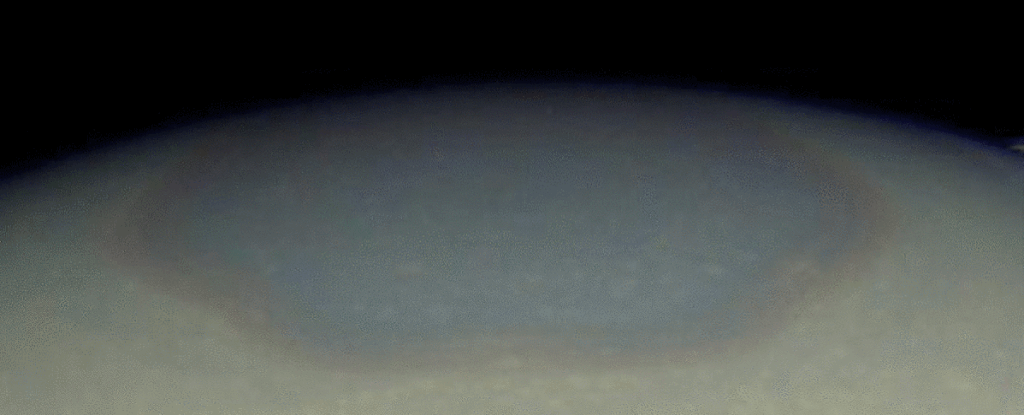The hexagonal storm on Saturn has changed its color - and no one knows why

The real color of the hurricane. Picture taken June 26, 2013 (Source: NASA / JPL-Caltech / Space Science Institute / Val Klavans)
Saturn is one of the most unusual planets in the solar system. Of course, each planet is unique, but Saturn has several differences from other planets. First, it is the gas giant. Secondly, Saturn has rings. Thirdly, there has been a storm here for hundreds of years, and this object has a hexagonal shape.
Now it turned out that this atmospheric vortex also changes its color over time. During the four years of observation, the color of the hexagon changed from blue to golden. Moreover, experts can not yet answer the question "why?". There are only a few assumptions. One of them - the color changes due to seasonal changes in the atmosphere of the gas giant.

')
Saturn's hexagonal storm was discovered about 30 years ago. Its diameter is 32 000 km, depth - at least 100 kilometers. The speed of movement of atmospheric masses here is 150 m / s. The "eye" of a hurricane is about 50 times the size of an average "eye" of a hurricane on Earth. Last year, astronomers have posted a video of the rotation of the object, collected from a variety of photos that were received by the Cassini. We are talking about using about 30 thousand photographs of Saturn.
Scientists say that every point of a hurricane rotates around a center at a speed approximately equal to the speed of rotation of the planet around its axis. According to experts, the hurricane is constantly creating new and new clouds. The hurricane itself is located at the north pole of the planet. Perhaps this atmospheric object has existed for dozens and hundreds of years .
During the years of studying the hurricane, astronomers have received a large amount of information about this atmospheric phenomenon, and understand well the processes occurring inside the hurricane. But why the hurricane changes its color is still a mystery. In addition, the mystery is the force that makes the plot of the atmosphere of the giant planet rotate. Making a whirlwind is not so difficult, scientists say, but to maintain its rotation for hundreds of years is much more difficult. “Water can easily be made to rotate in a bucket. Revolving, it will form a funnel in the center. But there are no buckets on Saturn, besides, the hurricane here is of hexagonal shape, it is not a circle. ”

According to representatives of NASA, the reason for changing the color of the hurricane may be seasonal changes. Saturnian year lasts 29 Earth years. The change of seasons on Saturn occurs about once every seven years. Recently, the planet receives more sunlight than in the previous season - there was a "winter" here. Maybe the increase in the amount of energy received by the planet is the reason for the gilding of the hurricane.
“The change of color is probably only a consequence of the change of seasons on Saturn. In particular, the color transition from bluish to golden can be explained by the passage of photochemical reactions in the atmosphere, ”a NASA statement said . Interestingly, in 2017 it will be possible to observe the Saturnian solstice.
How does all this work? Perhaps, scientists say, the hexagon functions as a barrier that prevents the ingress of aerosol and particles formed from the outside, inside. A closer look at the structure of a hurricane shows that two different types of particles gather within the hurricane and behind its walls.
“Inside the hexagon there are a lot of small clouds, and beyond it there are more large clouds. The hexagon works as a barrier, in some ways it looks like a hole in the ozone layer of the Earth, ” said Kunio Sayanagi, a member of the Cassini project team.
During the polar winter of Saturn, which lasted from November 1995 to August 2009, no aerosols were observed in the atmosphere at the North Pole of the gas giant, which are formed due to photochemical reactions. Basically, we are talking about the interaction of the rays of the sun and the atmosphere of the planet. In this case, the hexagon has a bluish color.
Since August 2009, Saturn has begun to receive more and more sunlight. It is possible that in a few years the sun's rays helped to form a large amount of aerosols in the hexagon and in the atmosphere at the entire north pole. As a result, more “fog” appeared here and Saturn turned golden.
"Other phenomena can play a role here," the NASA website says . "Scientists believe that seasonal changes, including an increase in the amount of solar energy absorbed by Saturn, are likely to affect the winds at the poles."
Now the Cassini interplanetary station is in orbit of Saturn, studying this planet and its satellites. Previously, with the help of scientists, they learned that Saturn often falls precipitations in the form of rains from liquid helium. According to astronomers, helium moves from the upper atmosphere to the lower layers, resulting in rain. Scientists have been able to model the conditions for the occurrence of precipitation of this kind; now the factors affecting the loss of helium precipitation are known.
Source: https://habr.com/ru/post/398531/
All Articles